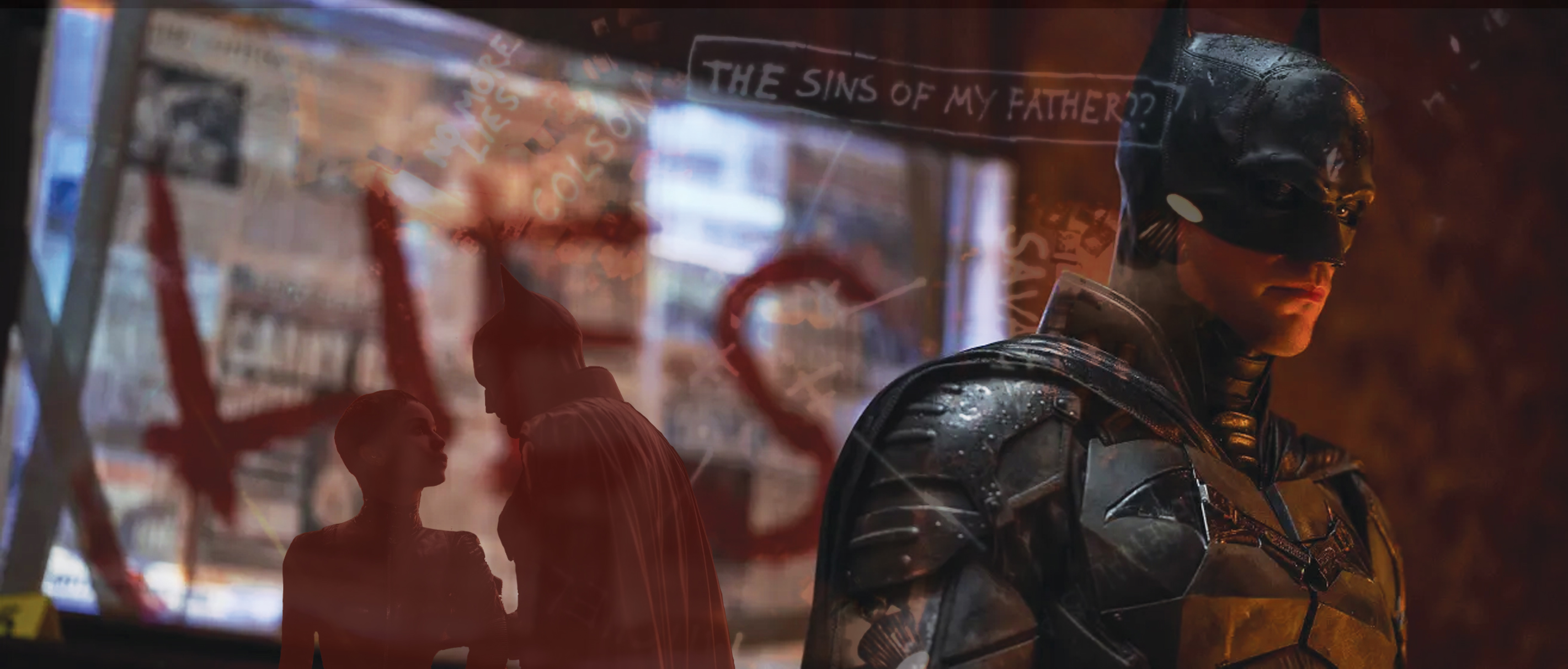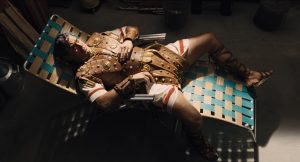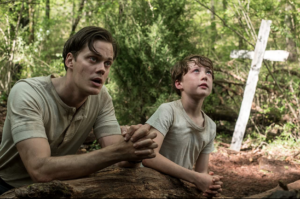The Batman (2022) sets its scene on Halloween. It’s the scariest night of the year, and the streets of Gotham City are rife with crime. As a group of vandals with off-putting skull facepaint terrorize an innocent man, a can of spray paint rolls away into a sheet of black shadow. The camera lingers. To the naked eye, the gloom seems empty—and yet there’s this creeping feeling that someone hides in its folds. An inexplicable presence we’ve all felt in movies before. Finally, out comes a masked vigilante in the classic black Batsuit to match the black shadows. While most of the thugs shake in fear, one scoffs at the costume, “Who the hell are you supposed to be?” For audience members the question is almost comedic. It’s impossible not to know the classic character for whom everyone is settled in their theater seats. But as our masked vigilante pauses and looks up with nothing but rage in his eyes, fists balled, we have a feeling this guy’s about to find out.
The Batman is an audacious name for a movie. There’s something so definitive about it, so singular—ironic considering how many variations of the titular superhero there have been. Ever since the character debuted in May 1939 in Detective Comics No. 27, we’ve seen him in every fashion imaginable: He’s appeared in movies, shows, and toy collections; he’s faced clowns, cats, and scarecrows; films about him have been critically acclaimed, ridiculed, and turned into cult classics.
After decades of interpretation and numerous actors inhabiting the costume, moving the character forward once again seemed like an impossible task. But in 2019, another Batman film, this time directed by Matt Reeves and starring Robert Pattinson, former Twilight leading man and Harry Potter alum, was announced. The casting decision caused backlash from longtime Batman fans, even resulting in a petition with over 6,000 signatures to reverse it. After all, wasn’t Pattinson that one guy from that one teen movie? The one mostly good at cringey intense stares? Hadn’t he spent the last, like, decade shying away from franchise films? How could he possibly be, not just any Batman, but “The Batman”?
Three years later, and delayed twice by the COVID-19 pandemic, the film’s release means the people can finally reach a verdict. Despite numerous past iterations of Gotham’s defender, The Batman manages to set itself apart and soar above a crowd of previous remakes thanks to its fresh but vintage style and sense of focus.
As with every film in the canon, the film follows Bruce Wayne (Pattinson), the reclusive billionaire who doubles as a disguised vigilante, Batman. When a killer begins to leave behind a series of humorous but twisted cards with chicken-scratch font clues addressed to the Dark Knight himself, Batman follows the trail and weaves his way through grimy Gotham, accompanied by Detective Jim Gordon (Jeffrey Wright). Along the way he picks up Catwoman, a.k.a. Selina Kyle (Zoë Kravitz), a morally gray cat burglar with her own motives to uncover the killer. It’s equal parts an action film and a modern twist on the dramatic noir crime mysteries of the 1940s. Suspense hisses like a live wire.
While the first instinct may be to compare this new rendition to The Dark Knight trilogy, it’s much more revealing to look at how it pays homage to Se7en (1995), a psychological thriller about two detectives hunting down a serial killer. Just like Se7en, this movie doesn’t spell everything out. It pulls viewers from one clue to the next alongside our sleuthing lead characters. Bringing us along for the mystery puts audience members in the seat of the Caped Crusader himself as he works his way through the many questions the case (and the city) holds.
At its heart, The Batman is about Batman. Okay of course it is, but it’s an element taken for granted in some other depictions of Batman. When people first think about him, it’s typically in terms of a nemesis: the sadistic Joker, or the distinctive Penguin, or the darkly humorous Riddler. Of course, these villains are some of the most interesting characters in the comic book universe, but films that involve them often allow the villains to dominate the focus, neglecting the fact that the titular hero is just as layered as his nemeses. This film changes that up from the get-go with Wayne’s diaristic narration acting as the film’s anchor.
We are presented with a Batman still in development—not fully formed, as he only started donning the costume two years prior to when the film begins, but established enough that his reputation carries weight. Criminals quake at the mere sight of the Bat-Signal in the sky; the few that don’t take it seriously instantly regret it. It’s an origin story of sorts, but not the kind where we have to relive his tragic familial losses (images of his parents being shot by a robber’s gun in an alley and his mother’s pearls splashing on the ground are all too familiar to fans). No, this origin story begins with an already trauma-riddled Bruce Wayne, allowing us to witness his transformation from a vengeful vigilante to a hero caring for his city. Gone is the front of the rich playboy common in other popular depictions of the character—here, we have a troubled soul with a lot on his mind and his crime-solving plate.
Pattinson plays the character like he was born for it. Although he has previously spent years disparaging his most iconic role, the dreamy Edward Cullen from Twilight, the experience seems to have come in handy for playing this similarly solemn character with a hidden double life. Who could have guessed the vampire and the bat would have so much in common? Pattinson’s Batman is menacing, he’s complex, he’s…cool? It may seem superficial, but it’s important to say—this movie is cool! And for the newest iteration of Batman to be viewed that way is a particular achievement. Translating stories from comic book to silver screen is not always easy. Certain things just look better on paper than in live-action. Over the years, Batman has suffered from people gradually thinking of him as one of the more one-note, helpless heroes without superpowers, a characterization only made worse by the constant comparisons to his threatening villains and larger-than-life peers. But this movie makes smart cinematography and design choices to up Batman’s intrigue. Techniques common in the horror genre—discomforting, slow dolly-ins into negative space, for example— build anticipation for him to emerge from the darkness. The design of Batman’s cowl leaves Pattinson’s strong chin bare but almost completely covers the top half of his face, focusing attention on his piercing blue eyes. Color grading does its job too: The bright yellows of explosions and warm reds of fires act as the only sources of light in scenes that would otherwise be pitch black, making for visually arresting shots. An aerial view of Batman leading citizens out of a dark cave using nothing but a glowing red torch is particularly memorable.
Zoë Kravitz is the perfect match for our brooding Batman. The actress is captivating every moment she is on screen, exuding the sleek confidence for which Selina Kyle is loved while also working with Reeves’ script to bring new levels of depth to the character with her own emotional development. The movie follows the blossoming of an undefined but immediate bond between the two characters. The chemistry between the Bat and the Cat is undeniable (I, for one, held my breath everytime Pattinson and Kravitz shared the screen), but the real glue holding this sudden pairing together is the pain they share. It is satisfying to watch two characters fit together simply like a jigsaw puzzle. Each lives a double life in Gotham but fills very different roles in the place: one, the son from an elite family; the other, a waitress at a nightclub. Each has been left broken by an unforgiving city that has taken their loved ones and spurred them toward revenge.
The fantastic design elements are accented by what is, in my opinion, the best score ever made for a superhero movie—a melodramatic score to accompany a melodramatic film. Award-winning composer Michael Giacchino (known for his work on Marvel movies, Pixar films, and more) strikes again and creates the perfect theme for Batman, an ominous recurring four-note motif not dissimilar to Darth Vader’s. Several of the tracks also include swelling strings that often sound reminiscent of bats screeching. According to Reeves, the score was “key for [Pattinson] to get into character,” as it told the actor the most about who Batman was out of all the references he was given to study.
There’s clearly thought behind the crafting of the protagonist. But where does that leave the antagonists? Don’t worry, there’s enough star quality for everyone—what would a Batman movie be without its bad guys to fight? The Batman takes a Riddler known for his camp looks and corny jokes (and for Jim Carrey’s depiction, we are eternally grateful) and gives him a darker spin. Paul Dano brings an eerily unsettling presence to his Riddler, his mask producing muffled speech and heavy breathing that fills the soundscape with an uncomfortable dread. Despite the movie following Batman on his quest to chase this elusive killer, we learn more and more about the Riddler’s character through the cryptic messages he leaves around. We also have the Penguin (an unrecognizable Colin Farrell), a mob boss with close connections to Gotham’s hidden affairs. Apart from these two generally being interesting to watch face off against Batman, they’re also the main source of humor in this otherwise heavy film. The Riddler’s elaborate puns elicit some chuckles (once you figure them out) and who can keep a straight face while listening to the Penguin’s hilariously thick New York mobster accent?
Despite having such excellent villains, the movie makes sure it’s not about them. Gotham is not evil because of one or two bad apples; instead, it’s a whole hidden system perpetuated by the elites that turns this city corrupt (this theme of individual crimes vs. the rich people that cause them holds a critique that is applicable to the real world). The focus is still on our Batman as he must face this realization, all while still resenting the common criminals of the city, like the one that shot his parents when he was just a child.
This is all a lot for one superhero movie to pull off, hence the three-hour duration. In some ways, The Batman falls into the common trappings of a lengthy runtime. The film drops the ball for a second during its lead-in to the third act—the scene where Batman and the Riddler face off lacks the tension needed to keep the audience invested in the dialogue. Dano’s performance becomes a bit forced, bogging down what was meant to be a big reveal. Nevertheless, the grand finale regains intensity, and the stakes heighten once again. Additionally, the accumulating narrative structure makes retaining audience attention key to everything making sense, and a lengthy runtime leaves ample room for a viewer to fall out of the loop with the story. That being said, stunning stylistic choices and a captivating premise make it easy to want to follow along.
For a company whose movies are notorious for their darker aesthetics, the future of DC Films is looking bright. Following the successes of Zack Snyder’s Justice League (2021) and The Suicide Squad (2021) directed by the irreverent James Gunn, The Batman is the final piece of evidence needed to solidify what the film studio (and its audience) is starting to realize: Auteur-led standalone movies are where the company can have the edge over competing franchises. Recently, the film studio has been leaning into giving full creative direction to the minds of its directors without focusing too much on the extended universe of it all, resulting in actually meaningful movies. The Batman, for what feels like the 100th remake of the character, chooses to go against the grain with its narrative focus and noir influences, elevating the material beyond what has been done before while feeling close to the classic character’s roots. Certainly it’s earned the powerful, all-encompassing title of The Batman.





